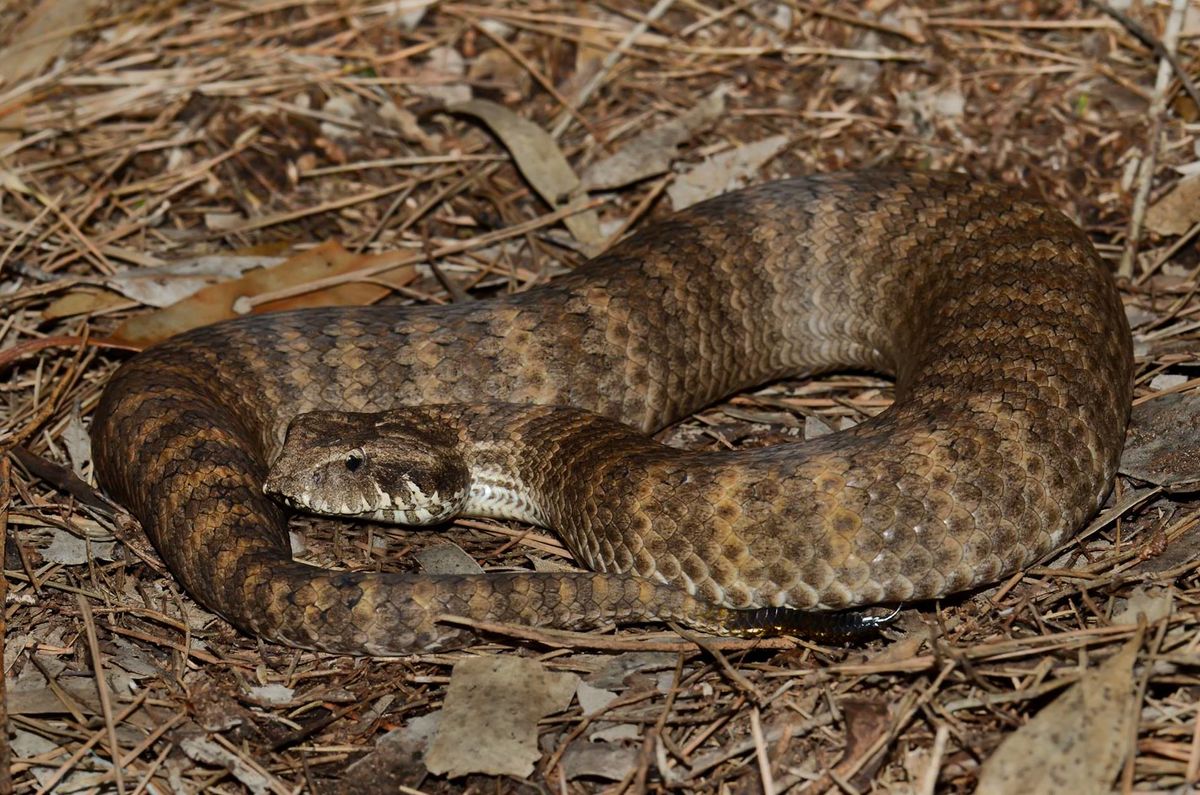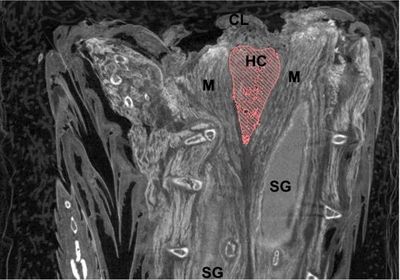ABOVE: A DiceCT image of a single transverse (horizontal) slice of a snake’s abdomen, showing its hemiclitores (labeled HC). Megan Folwell
Researchers give penises a lot of attention, historically speaking. This is especially true in snakes, as scientists know a good deal about the animals’ male reproductive organs, but relatively little about the females’ organs, especially the clitoris. This led some scientists to conclude that the structure has little to do with mating in snake species, and some doubted that it exists at all.
Now, a study published today (December 13) in Proceedings of the Royal Society B sets the record straight: the snake clitoris not only exists, it may also play important roles in reproduction. Researchers at the University of Adelaide have, for the first time, described the striking diversity of snake hemiclitores in nine snake species. In doing so, they’ve provided evidence that the structure is widespread among snakes and likely has a vital function. This study adds to the growing pile of evidence that the clitoris is likely no less important than the penis when it comes to copulation across the animal kingdom.
“The study is really interesting,” says Soledad Valdecantos, a biologist at the National University of Salta in Argentina who was not involved in the study, in an interview in Spanish. She says that she wasn’t surprised to learn that snakes have a clitoris, since “the presence of the hemiclitoris in reptiles is very common.” However, she adds that “[i]t is super important because it’s the first study where we see the internal morphology.”
Since the field’s beginning in the 1800s, researchers have spent two centuries studying and documenting the remarkable diversity of snake and lizard penises, actually called “hemipenes” (singular: hemipenis) due to the fact they have two penises that are connected in a branching structure.
See “Evolution of the Penis”
In contrast, the subject of female reproductive organs, even in snakes, has long been considered “taboo,” says University of Adelaide graduate student Megan Folwell, a coauthor of the study. The female hemiclitores in reptiles, which are thought to derive from the same ancestral organ as the animals’ hemipenes and also come in a paired structure, weren’t described in lizards until 1995, and since then, there have only been a few studies on the subject, she says. Researchers’ focus on the hemipenes shaped their conclusions about snake sex and reproduction. Scientists assumed that the clitoris was vestigial or even lost in some species of scaled reptiles.
“It’s good that the research community is starting to look at the other side of the story,” Folwell says.
Folwell, a graduate student in biologist Kate Sander’s lab at the University of Adelaide, was studying the morphology of snake hemipenes when she realized how little biologists knew about the hemiclitores. She also noted inconsistencies in the existing scientific literature about what constituted hemiclitores, with some studies seemingly mislabeling the organs. In some studies, the scent glands, also situated on the snake’s ventral side near the tip of the tail (just below the hemipenes in males), had been labeled as the hemiclitores. In others, hemipenis-like structures in hermaphroditic snakes had also been dubbed hemiclitores. In a review published earlier this year, Folwell and her coauthors concluded that, based on these interpretations, essentially no one had really ever done a true comparative study on sex organs in snakes.

So, to clear up this confusion, Folwell and a team of researchers took a more thorough look. They started by dissecting death adders (Acanthophis antarcticus) they already had in the lab. The dissection involved three steps: cutting open the abdomen, carefully dissecting the scent glands, and cutting through a thin layer of muscle. Folwell says that the first time she did this dissection, she saw the structures she identified as hemiclitores, clear as day.
“At this point, I [was] very ecstatic. It’s nothing like what anyone’s seen before or described,” she says.
She went on to study the organ’s structure. She stained the putative hemiclitores with dyes that selectively highlight vasculature, nerve, and erectile tissue, doing the same with the hemipenes of age-matched snakes. In females, the structure was highly vascularized, which is consistent with findings in other reptiles and mammals. And like hemipenes, hemiclitores were highly innervated. Unlike hemipenes, however, hemiclitores didn’t contain muscle fibers and were instead composed purely out of collagen.
Folwell also created a 3D model of the organ by using DiceCT, a form of iodine-based tomography that allowed her to visualize thin cross-sections of snake tissues. That allowed her to see the shape and size of the whole structure in detail.
She and her team completed this procedure with nine species of snakes from four families, finding that there was a huge variation in the size, shape, and tissue composition of the organ. “That was fantastic,” Folwell says, adding that the variety indicates that selective pressures likely shaped snakes’ genitalia.
While snake hemiclitores likely have a function, that function remains unclear—for now. Folwell has some hypotheses, though: In many other animals, the clitoris “sends a signal to the brain to start preparing the body for copulation,” says Folwell, and the same could hold true in snakes. Many snake hemipenes are like “medieval contraptions,” covered in everything from spikes to suction cups to hooks. Therefore, hemiclitoral stimulation could encourage vaginal lubrication and relaxation, says Folwell, to prevent trauma or damage after the mating process.
The study also may have implications for how snakes choose their mates. In many species of snakes, scientists believe that snake mating happens mainly through coercion. But this study suggests that it might instead happen through “seduction,” says Folwell.
Next, Folwell says she’d like to learn more about the neural pathways that involve the hemiclitores. She also plans to understand more about the role the hemiclitores play in snake behavior, particularly during copulation, and whether and how they’re stimulated through mating behaviors such as vibration and tail wrapping.
The findings show that the clitorises are even more widespread among amniotes—the group of vertebrates that includes mammals, reptiles, and birds—than previously thought, indicating a single, ancestral origin for the structure. And all these clitorises need further investigation, as researchers are just beginning to understand their functions, says Folwell. Such insights and evolutionary context could shed light on disparate fields, from animal behavior to human sexual health.
See “Why Female Orgasm Evolved”
“It’s no doubt that we want to see more acceptance and enthusiasm around female genitalia and female reproductive research,” says Folwell. Until then, she’ll enjoy the little shock people receive when she tells them what she does. “It’s a fun party gimmick,” she says.






